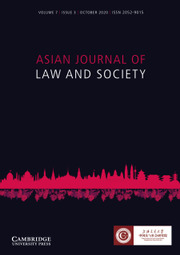No CrossRef data available.
Article contents
Concretising the Legal Professional Community in Late Imperial China, c. 1700–1900
Published online by Cambridge University Press: 10 October 2024
Abstract
This article examines the empire-wide legal professional community that emerged for the first time in Chinese history during the Qing period (1644–1911). By analyzing a wide range of archival records and primary sources, this study provides valuable insights into the dynamic configurations of late imperial China’s legal culture and juridical field, as well as the thousands of legal specialists who shaped them. The findings challenge much of the received wisdom about late imperial China, which has too often been assumed as a Confucian society that discouraged the use of law and legal expertise and was therefore unlikely to have witnessed so many Confucian literati becoming legal specialists, both within and outside the judicial system.
- Type
- Research Article
- Information
- Asian Journal of Law and Society , Volume 11 , Special Issue 3: Comparative Legal History in an Asian Context , September 2024 , pp. 260 - 287
- Copyright
- © The Author(s), 2024. Published by Cambridge University Press on behalf of Asian Journal of Law and Society


